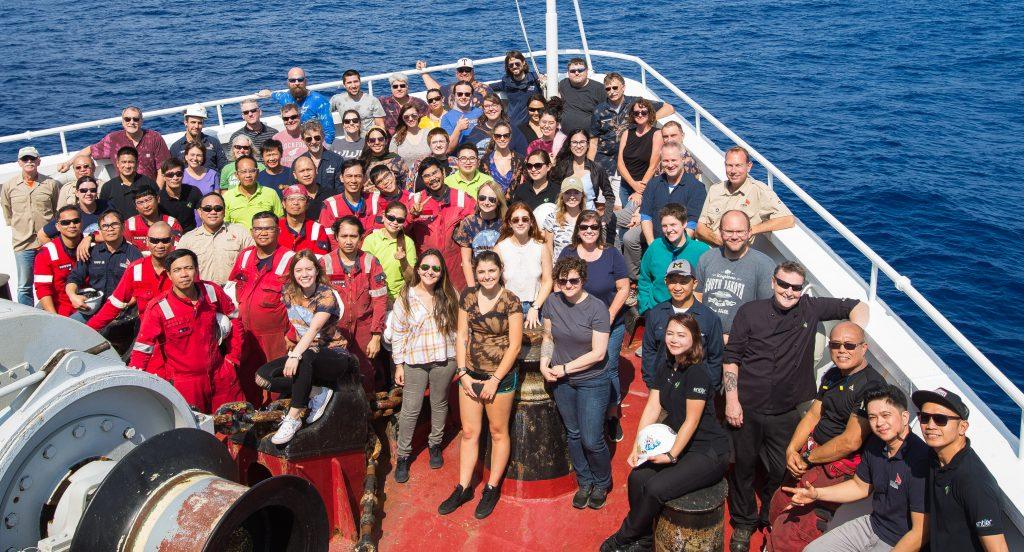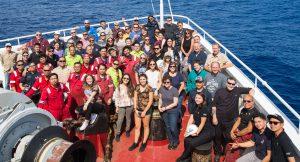
The Big Picture
The JOIDES Resolution (JR) is making her way up the coast of Central America, steadily heading to her next port call in San Diego. My education outreach colleague, Kristen, and I are once again having an informal talk with a science party member here on Expedition 385T (see “The Long Game” blog for our talk with Dr. Becker). Today we are talking to the Expedition Project Manager of this expedition, Dr. Peter Blum. The three of us instinctively head to the outside of the ship in search of fresh air and sunshine. A little wooden bench tucked into an outside walkway provides a porch-like setting, and we settle in. The Pacific Ocean rolls past as Dr. Blum’s angular frame leans against the railing, limbs loosely folded in relaxed composure. His faded blue plaid shirt flaps lightly in the breeze. He exudes a mixture of confidence, approachability, and measured interest. The sky is a beautiful, crisp teal blue with just the right amount of puffy clouds to make the air pleasant and welcoming.
Just like the setting, our conversation is relaxed and invigorating. I open things up with a question I think is meaningful for people to understand but not often generally discussed. Why is it important that we understand the structure of the sub-seafloor, and why is the action of water throughout this structure so critical to understand? I ask Dr. Blum for his thoughts, and the conversation just flows. Dr. Blum immediately responds that the largest aquifer on the planet could very well be in the Earth’s oceanic crust, and that the biological processes in parts of this aquifer and currently being studied may inform us of no less than the beginning of life. I hadn’t thought of the water under the seafloor as an aquifer before. Dr. Blum doesn’t mean that there are large bodies of water sloshing around beneath the crust – aquifers are bodies of porous sediment or rock that contain water or through which water is flowing.
Scientists are studying where and how water may exist in both the crust and deep in the mantle. For years, IODP scientists have been investigating how and where water flows into, through, and out of the crust below the ocean floor. The estimates on the volume of water in this part of our planet are surprisingly large, and our understanding of how microbial life is distributed in these waters has just begun. Scientists are also finding indications that water may play a role in the mechanics of Earth’s mantle. The possibilities being explored currently include the idea that some minerals in the transition zone between the upper and lower mantle have the ability to “hold” 1-3% of their weight in water. A small percentage like that seems like a tiny bit, but when you start to contemplate the huge volume of these minerals in the transition zone between the upper and lower mantle, the total amount of potential water quickly adds up.
Water is important, that we all know. It serves as one of the key ways in which the chemicals of our planet transfer between rock, water, ocean, and atmosphere. View this idea with the concept that water plays an integral role in plate tectonics, and you begin to see why understanding the way water moves in any of its forms through Earth’s processes is important.
Dr. Blum points out that understanding Earth’s processes allows us to understand life itself. Science is more than just wanting to explore and discover new things. He emphasizes the need to understand the way things exist naturally and how they work. Understanding our planet’s processes allows us to choose our actions wisely. “Life depends on the way things are,” says Dr. Blum. “To be smart about it, we have to understand Earth’s systems.”
Over the years, Dr. Blum has served in many roles for the International Ocean Discovery Program. Currently, Dr. Blum is the Expedition Project Manager on the JR. In this role, he does what it takes to make sure whatever is planned for the expedition has the best possible chance of succeeding. His job is to smooth the way for the science, and he cares deeply about doing it well. He gets quite animated when talking about the ways he and other talented people on the ship develop systems to support the science. To conduct research at sea, everyone on the ship must be prepared to tackle unforeseen problems without the usual support found on land. They need to fix what needs fixing, create contingency plan after contingency plan, and invent what needs inventing. Some of the equipment on the JR is one of a kind, a product of inventive minds solving problems or filling gaps that arise during scientific research. Sometimes new software must be developed, or existing equipment can be reconfigured to support the scientists’ work. It takes a special kind of person to thrive in deep ocean research.

Sometimes it is important to take a step back and consider the whole picture. Science research that helps us understand how our planet works also helps us understand how to be successful at living on our planet. The work conducted by the team out here plays a specific part in advancing that understanding, whether our role is that of the principle investigator with the great ideas, the analytical specialist producing high-quality data, the technician building new measurement devices and keeping the labs humming, the project manager keeping activities connected, or the blog reader curiously learning what it is all about. We all have a part to play in the big picture.